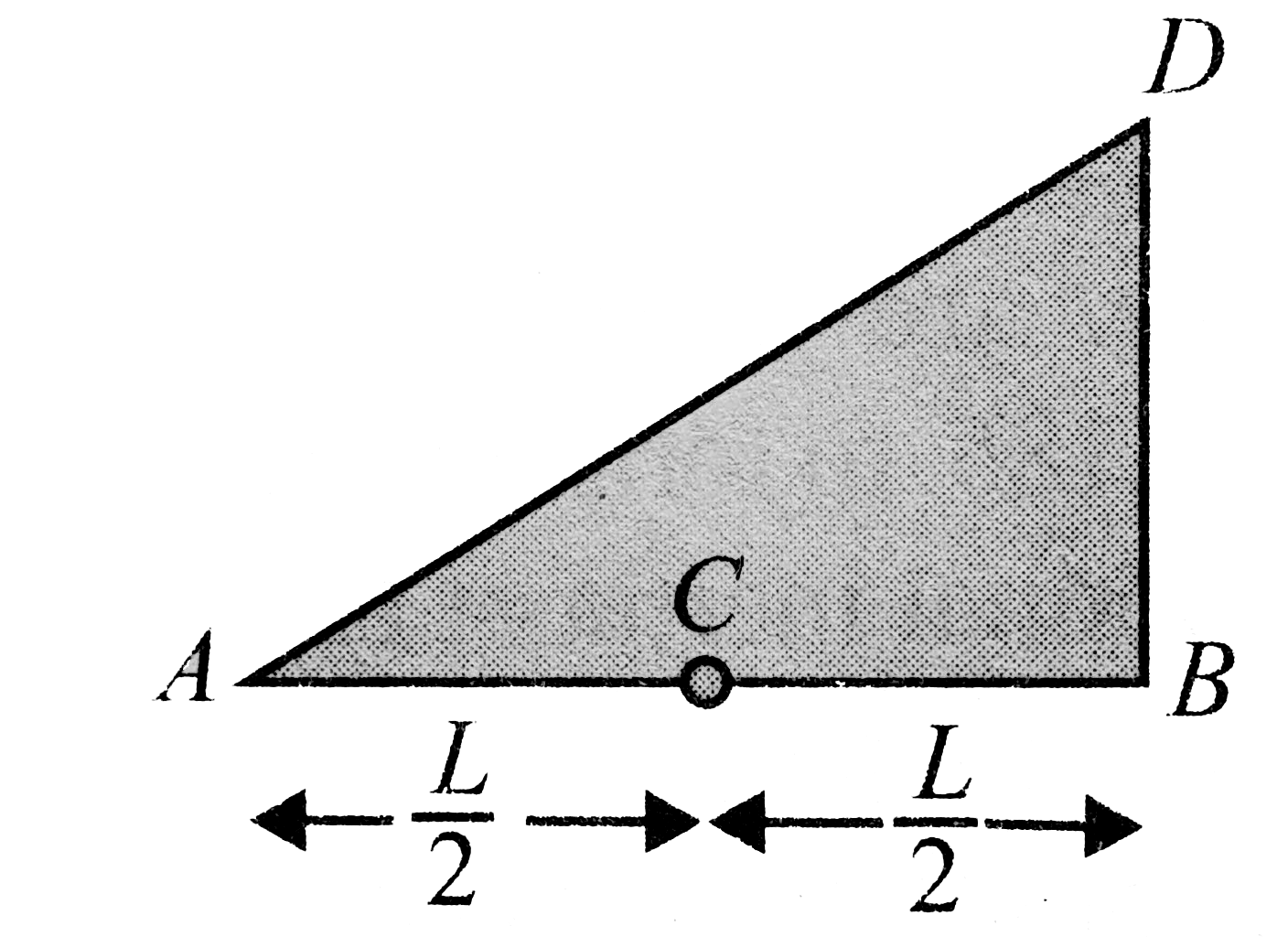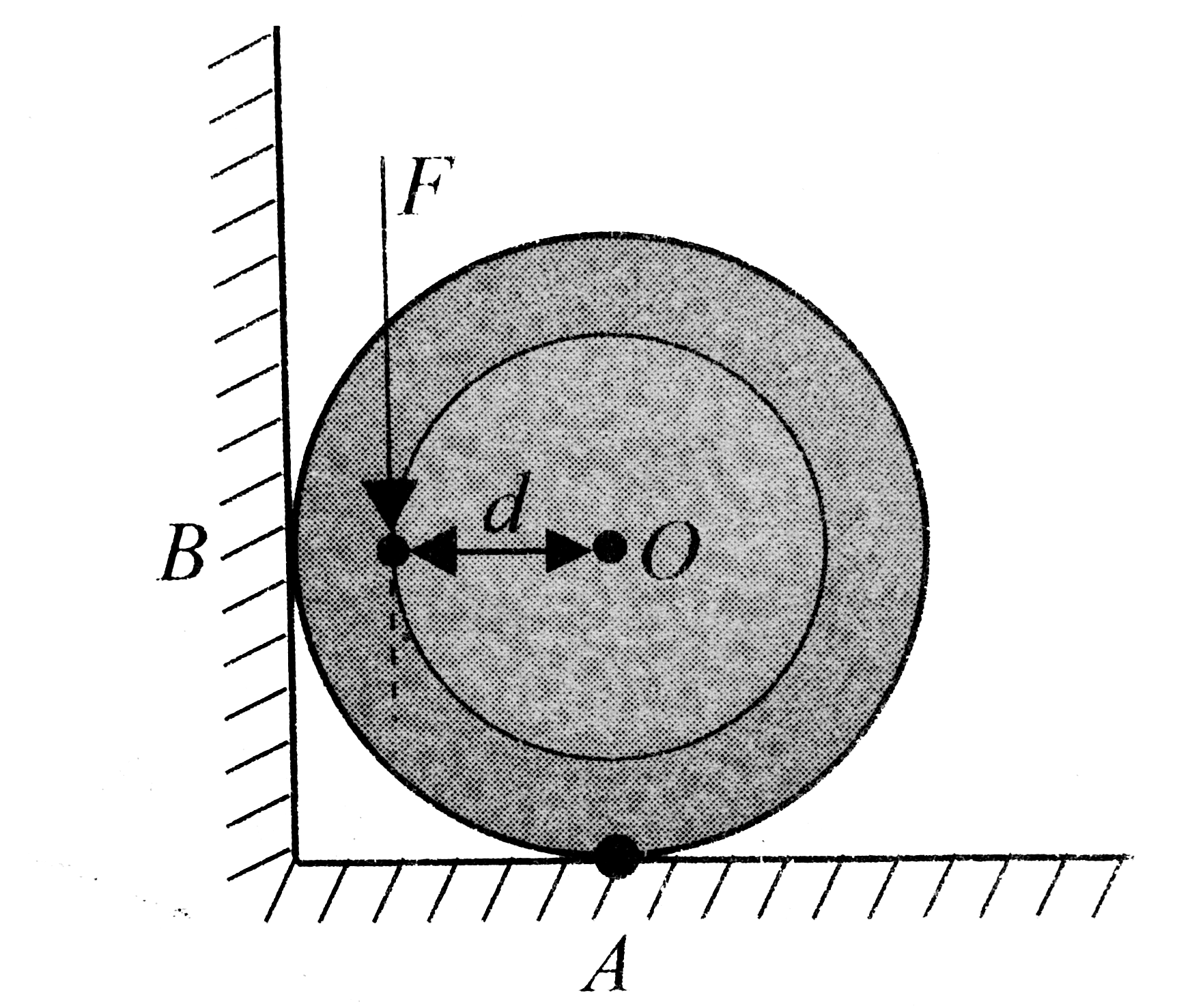A ring of mass 3kg is rolling Without Slipping with linear velocity 1ms−1 on a smooth horizontal surface. A rod of same mass is fitted along its one diameter. Find total kinetic energy of the system (in J).
The correct Answer is:5
To find the total kinetic energy of the system consisting of a ring and a rod, we need to consider both the translational and rotational kinetic energies.
Step 1: Identify the components of kinetic energy
The total kinetic energy (KE) of the system will be the sum of the translational kinetic energy (TKE) and the rotational kinetic energy (RKE).
Step 2: Calculate the translational kinetic energy
The translational kinetic energy for the system is given by the formula:
TKE=12mv2
where:
- m is the total mass of the system,
- v is the linear velocity.
Since both the ring and the rod have the same mass of 3kg, the total mass m is:
m=3kg+3kg=6kg
Substituting the values:
TKE=12×6kg×(1m/s)2=12×6×1=3J
Step 3: Calculate the moment of inertia of the system
The moment of inertia I of the ring about its center is:
Iring=mr2=3kg⋅r2
The moment of inertia I of the rod about its end (using the parallel axis theorem) is:
Irod=13mr2=13⋅3kg⋅r2=r2
Thus, the total moment of inertia Itotal is:
Itotal=Iring+Irod=3r2+r2=4r2
Step 4: Calculate the rotational kinetic energy
The rotational kinetic energy is given by:
RKE=12Iω2
We know that ω can be related to v by the equation v=rω, which gives:
ω=vr
Substituting this into the RKE formula:
RKE=12(4r2)(vr)2=12(4r2)(1r2)=2J
Step 5: Calculate the total kinetic energy
Now, we can find the total kinetic energy of the system:
Total KE=TKE+RKE=3J+2J=5J
Final Answer
The total kinetic energy of the system is 5J.
---
The total kinetic energy (KE) of the system will be the sum of the translational kinetic energy (TKE) and the rotational kinetic energy (RKE).
The translational kinetic energy for the system is given by the formula:
TKE=12mv2
where:
- m is the total mass of the system,
- v is the linear velocity.
m=3kg+3kg=6kg
Substituting the values:
TKE=12×6kg×(1m/s)2=12×6×1=3J
The moment of inertia I of the ring about its center is:
Iring=mr2=3kg⋅r2
The moment of inertia I of the rod about its end (using the parallel axis theorem) is:
Irod=13mr2=13⋅3kg⋅r2=r2
Thus, the total moment of inertia Itotal is:
Itotal=Iring+Irod=3r2+r2=4r2
The rotational kinetic energy is given by:
RKE=12Iω2
We know that ω can be related to v by the equation v=rω, which gives:
ω=vr
Substituting this into the RKE formula:
RKE=12(4r2)(vr)2=12(4r2)(1r2)=2J
Now, we can find the total kinetic energy of the system:
Total KE=TKE+RKE=3J+2J=5J
The total kinetic energy of the system is 5J.
টপার এই প্রশ্নগুলো সমাধান করেছে
- RIGID BODY DYNAMICS 2BOOK - CENGAGE PHYSICS ENGLISHCHAPTER - RIGID BODY DYNAMICS 2EXERCISE - Fill In The Blanks
7 Videos
- RIGID BODY DYNAMICS 2BOOK - CENGAGE PHYSICS ENGLISHCHAPTER - RIGID BODY DYNAMICS 2EXERCISE - True/False
4 Videos
- RIGID BODY DYNAMICS 2BOOK - CENGAGE PHYSICS ENGLISHCHAPTER - RIGID BODY DYNAMICS 2EXERCISE - Linked Comprehension
71 Videos
- RIGID BODY DYNAMICS 1BOOK - CENGAGE PHYSICS ENGLISHCHAPTER - RIGID BODY DYNAMICS 1EXERCISE - Integer
11 Videos
- SOUND WAVES AND DOPPLER EFFECTBOOK - CENGAGE PHYSICS ENGLISHCHAPTER - SOUND WAVES AND DOPPLER EFFECTEXERCISE - Integer
16 Videos
সম্পর্কিত প্রশ্ন
A uniform cube of side a and mass m rests on a rough horizontal table. A horizontal force F is applied normal to one of the faces at a point directly above the centre of the face, at a height 3a4 above the base. What is the minimum value of F for which the cube begins to tip about an edge?
View SolutionA triangular platge of uniform thickness and densilty ismade to rotate about an axis perpendicular to the plane of the paper an a. passing through A b. passing through B, by the application of some foce F at C (mid point of AB) as show in figure. In which case is angular acceleration more?

View SolutionA man of mass 100kg stands at the rim of a turtable of radius 2m and moment of inertia 4000kgm2 mounted on a vertical frictionless shaft at its centre. The whole system is initially at rest. The man now walks along the outer edge of the turntable with a velocity of 1m/s relative to the earth
a. With what angular velocity and in what direction does the turntable rotate?
b. Through what angle will it have rotated when the man reaches his initial position on the turntable?
c. Through what angle will it have rotated when the man reaches his initial position relative to the earth?
View SolutionA solid cylinder with r=0.1m and mass M=2kg is placed such that it is in contact with the vertical and a horizontal surface as shown in Fig. The coefficient of friction is μ=(1/3) for both the surfaces. Find the distance (in CM) from the centre of the cylinder at .which a force F=40N should be applied vertically so that the cylinder just starts rotating in anticlockwise direction.

View SolutionThe average power transmitted across a cross section by two sound waves moving in the same direction are equal. The wavelength of two sound waves are in the ratio of 1:2, then find the ratio of their pressure amplitudes.
View SolutionAn impulse J is applied on a ring of mass m along a line passing through its centre O . The ring is placed on a rough horizontal surface. The linear velocity of centre of ring once it starts rolling without slipping is
View SolutionA ring of mass 3kg is rolling Without Slipping with linear velocity 1 ms^(-1) on a smooth horizontal surface. A rod of same mass is fitted along its one diameter. Find total kinetic energy of the system (in J ).
View SolutionA ring and a disc of same mass roll without slipping along a horizontal surface with same velocity. If the K.E. of ring is 8J , then that of disc is
View SolutionA ring of mass m is rolling without slipping with linear velocity v as shown is figure. A rod of identical mass is fixed alone one of its diameter. The total kinetic energy of the system is
View SolutionA ring and a disc having the same mass, roll without slipping with the same linear velocity. If the kinetic energy of the ring is 8 j , Find the kinetic energy of disc (in J)
View SolutionA ring and a disc roll on the horizontal surface without slipping, with same linear velocity. If bolh have same mass and total kinetic energy of the ring is 4 J, then total kinetic energy of the disc is
View Solutionm द्रव्यमान की एक डिस्क एक क्षैतिज मेज पर बिना फिसले वेग से लुढ़क रही है। इसकी कुल गतिज ऊर्जा कितनी है?
View SolutionA solid sphere of mass 10 kg and diameter 5 cm rolls without slipping on a smooth horizontal surface with velocity 5 cm/s. Its total kinetic energy is
View SolutionA ring and a disc roll on the horizontal surface without slipping with same linear velocity. If both have same mass and total kinetic energy of the ring is 4 J then total kinetic energy of the disc is
View SolutionA uniform thin ring of mass 0.4kg rolls without slipping on a horizontal surface with a linear velocity of 10 cm/s. The kinetic energy of the ring is
View SolutionA ring and a disc roll on the horizontal surface without slipping with same linear velocity. If both have same mass and total kinetic energy of the ring is 4 J then total kinetic energy of the disc is
View Solution

